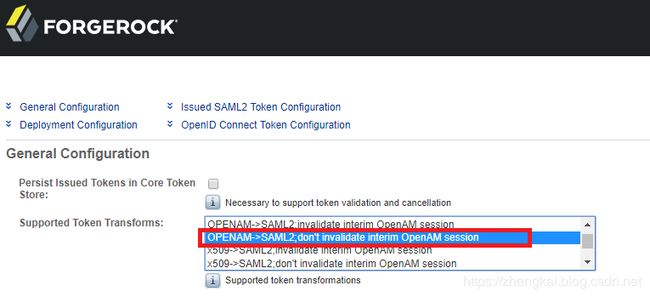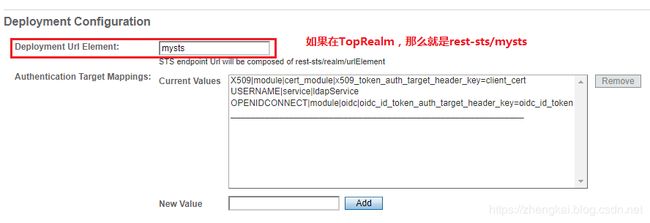What’s SAML2
SAML是安全断言标记语言(英语:Security Assertion Markup Language,简称SAML,发音sam-el),一种xml格式的语言。 有两个点: 第一是安全(Security), 第二是断言(assertion)。
先看它的核心概念断言(assertion)。 断言是什么? 就是做出判断的语言。比如一个例子:小红没有权限读取根目录。这就是一个断言。 这种“做出判断的语句”我们在很多场合都需要用到。 比如你在网上尝试登陆一个服务的时候, 这个服务需要知道你是不是合法的用户。 这个时候如果你能提供一个“安全,可靠,可信任”的断言:“***有权登陆XX服务”, 那么这个服务就知道你合法了, 于是就能为你提供服务了。 这个例子比较抽象,但基本上能表达断言在实际用例中的作用了。 实际上SAML2的大部分内容就在于证明你是谁,你拥有什么权限等等了。
接下来第二个概念就是安全(Security)了。 你能提供一个断言, 别人能不能假冒你提供一个断言从而骗取服务端的信任呢? 另外服务端为什么会信任你给的断言呢? 这就涉及到安全的问题了。为了防止断言被假冒,篡改。SAML中加入了安全措施。 当然现今能抵御假冒,篡改,重放攻击的利器就是公钥-私钥/keystore系统了。 通过给断言加上签名和加密,再结合数字证书系统就确保了SAML不受攻击。
Config With OpenAM SAML2
OpenAM配置SAML2分2种方式:
- 默认方式(本文采用默认方式,Sign Assertion)
- 开发方式(自定义AttributeMapper,TokenProvider)
默认方式和开发方式都是分3步走,只是配置有所不同而已:
- 配置SAML2 STS Instance
- 配置SAML2 Service Provider(Configure OAuth2 authorization server)
- 验证SAML2
配置SAML2 STS Instance
1.进入Top Level Realm,找到STS,这里的STS是Security Token Service的意思。

2.new一个STS,Supported Token Transforms选择OPENAM->SAML2,don't invalidate interim OpenAM session

3.Deployment Url Element就是这个STS的名称,这里要记住,后面会用到,拼接REST请求的时候,URL为rest-sts/stsName,那么我们就是rest-sts/mysts

4.这里定义一下issuer Id和Entity Id

5.详细设置SAML2 Sign相关
Sign Assertion,打勾√,启用断言签证,不签的话,报文很少KeyStorePath位于C:\Users\你的用户\openampro\openampro\keystore.jks(如果你的项目叫openam则为C:\Users\你的用户\openam\openam\keystore.jks)Keystore Password,记事本打开.storepass文件,明文copy即可Signature Key Password,记事本打开.keypass文件,明文copy即可


6.保存
配置SAML2 Service Provider
1.返回Dashboard,扎到Common Tasks下面的Configure SAMLv2 Provider

2.由于是本地Localhost的Provider,所以是选择Create Hosted Service Provider

3.默认配置即可,metadata会自动填写,如果没有就写上项目路径,Circle Of Trust随便写个cot或者mycot即可。

4.保存并返回查看

验证SAML2
1.POST请求authenticate接口获得以下authenticate报文,无需任何参数
http://localhost:8099/openampro/json/authenticate
{
"authId": "eyJ0eXAiOiJKV1QiLCJhbGciOiJIUzI1NiJ9.eyJvdGsiOiJraWM1cmM3aGVjN2dsbWIzYWZzczE4MHQ0cCIsInJlYWxtIjoiZGM9b3BlbmFtLGRjPWZvcmdlcm9jayxkYz1vcmciLCJzZXNzaW9uSWQiOiJBUUlDNXdNMkxZNFNmY3c0OFhTUDNlR2NIZVB1VUN3bW9IdGRyVWpsdHZsX1BIby4qQUFKVFNRQUNNREVBQWxOTEFCTTBOVFEzTURVMU1URTBOVGMwTXpFMU1EZzVBQUpUTVFBQSoifQ.Xq4okO5FjamU62bu0xeZbUSE15pCaG_fKw9XseMJi64",
"template": "",
"stage": "DataStore1",
"header": "Sign in",
"callbacks": [
{
"type": "NameCallback",
"output": [
{
"name": "prompt",
"value": "User Name:"
}
],
"input": [
{
"name": "IDToken1",
"value": ""
}
]
},
{
"type": "PasswordCallback",
"output": [
{
"name": "prompt",
"value": "Password:"
}
],
"input": [
{
"name": "IDToken2",
"value": ""
}
]
}
]
}
2.Copy上一部获取到的报文在body/raw里面,然后补全authenticate报文的账号(IDToken1-value)和密码(IDToken2-value),继续请求该接口
http://localhost:8099/openampro/json/authenticate
"callbacks": [
{
"type": "NameCallback",
"output": [
{
"name": "prompt",
"value": "User Name:"
}
],
"input": [
{
"name": "IDToken1",
"value": "这里填写账号"
}
]
},
{
"type": "PasswordCallback",
"output": [
{
"name": "prompt",
"value": "Password:"
}
],
"input": [
{
"name": "IDToken2",
"value": "这里填写密码"
}
]
}
]
AQIC5wM2LY4SfczBElQ-gyrwsTOLXPZscWBxk776W1IYfS4.AAJTSQACMDEAAlNLABM0ODEyODAzNTQxNzU4MDE3MDA3AAJTMQAA
4.拼接报文,把tokenId填入session_id后面的值,然后POST请求translate接口,进行OPENAM->SAML2报文转换
http://localhost:8099/openampro/rest-sts/mysts?_action=translate
{
"input_token_state":
{
"token_type": "OPENAM",
"session_id": "AQIC5wM2LY4SfczBElQ-gyrwsTOLXPZscWBxk776W1IYfS4.*AAJTSQACMDEAAlNLABM0ODEyODAzNTQxNzU4MDE3MDA3AAJTMQAA*"
},
"output_token_state":
{
"token_type": "SAML2",
"subject_confirmation": "BEARER"
}
}
{"issued_token":"
\r\n
<saml:Issuer>stsidsaml:Issuer>
\r\n
<ds:SignedInfo>\r\n
\r\n
\r\n
\r\n
<ds:Transforms>\r\n
\r\n
\r\n
ds:Transforms>\r\n
\r\n
<ds:DigestValue>AZShA8hm3+BuU8SkTQtbvkjpl9o=ds:DigestValue>\r\n
ds:Reference>\r\n
ds:SignedInfo>\r\n
<ds:SignatureValue>\r\nRkuIgun5A6sInaD3HWZ7CbQXkiWDxTR2zJ6o/h4IOf7jutSl6lCLEHUs1qSjyILO1xeOMS3VsDpn\r\nplpYfZF3tHornzdDm++9x538qDnxlzIHVN3WQKu9yLoqrkw0arU1I+KZb8dKnZHIPf9RnK96RLuz\r\nO4yEsjQrPpB3hRBF0oI=\r\nds:SignatureValue>\r\n
<ds:KeyInfo>\r\n
<ds:X509Data>\r\n
<ds:X509Certificate>\r\nMIICQDCCAakCBEeNB0swDQYJKoZIhvcNAQEEBQAwZzELMAkGA1UEBhMCVVMxEzARBgNVBAgTCkNh\r\nbGlmb3JuaWExFDASBgNVBAcTC1NhbnRhIENsYXJhMQwwCgYDVQQKEwNTdW4xEDAOBgNVBAsTB09w\r\nZW5TU08xDTALBgNVBAMTBHRlc3QwHhcNMDgwMTE1MTkxOTM5WhcNMTgwMTEyMTkxOTM5WjBnMQsw\r\nCQYDVQQGEwJVUzETMBEGA1UECBMKQ2FsaWZvcm5pYTEUMBIGA1UEBxMLU2FudGEgQ2xhcmExDDAK\r\nBgNVBAoTA1N1bjEQMA4GA1UECxMHT3BlblNTTzENMAsGA1UEAxMEdGVzdDCBnzANBgkqhkiG9w0B\r\nAQEFAAOBjQAwgYkCgYEArSQc/U75GB2AtKhbGS5piiLkmJzqEsp64rDxbMJ+xDrye0EN/q1U5Of+\r\nRkDsaN/igkAvV1cuXEgTL6RlafFPcUX7QxDhZBhsYF9pbwtMzi4A4su9hnxIhURebGEmxKW9qJNY\r\nJs0Vo5+IgjxuEWnjnnVgHTs1+mq5QYTA7E6ZyL8CAwEAATANBgkqhkiG9w0BAQQFAAOBgQB3Pw/U\r\nQzPKTPTYi9upbFXlrAKMwtFf2OW4yvGWWvlcwcNSZJmTJ8ARvVYOMEVNbsT4OFcfu2/PeYoAdiDA\r\ncGy/F2Zuj8XJJpuQRSE6PtQqBuDEHjjmOQJ0rV/r8mO1ZCtHRhpZ5zYRjhRC9eCbjx9VrFax0JDC\r\n/FfwWigmrW0Y0Q==\r\nds:X509Certificate>\r\n
ds:X509Data>\r\n
ds:KeyInfo>\r\n
ds:Signature>
<saml:Subject>\r\n
amadminsaml:NameID>
\r\n
saml:SubjectConfirmation>\r\n
saml:Subject>
\r\n
<saml:AudienceRestriction>\r\n
<saml:Audience>stsidsaml:Audience>\r\n
saml:AudienceRestriction>\r\n
saml:Conditions>\r\n
<saml:AuthnContext>
<saml:AuthnContextClassRef>urn:oasis:names:tc:SAML:2.0:ac:classes:PreviousSessionsaml:AuthnContextClassRef>
saml:AuthnContext>
saml:AuthnStatement>
saml:Assertion>"}
以下部分为shell+json自动化配置,部分核心配置
使用JSON配置
{
"invocation_context": "invocation_context_client_sdk",
"instance_state": {
"persist-issued-tokens-in-cts": "false",
"supported-token-transforms": [{
"inputTokenType": "OPENAM",
"outputTokenType": "SAML2",
"invalidateInterimOpenAMSession": false
}],
"custom-token-validators": [],
"custom-token-providers": [{
"customTokenName":"SAML2_XXX",
"customOperationClassName":"com.xxxcompany.sts.tokengeneration.saml2.SamlTokenProvider"
}],
"custom-token-transforms": [{
"inputTokenType": "OPENAM",
"outputTokenType": "SAML2_HSM",
"invalidateInterimOpenAMSession": false
}],
"deployment-config": {
"deployment-realm": "/sdex_global",
"deployment-url-element": "ssotoken_transformer_xxxapp",
"deployment-auth-target-mappings": {},
"deployment-offloaded-two-way-tls-header-key": null,
"deployment-tls-offload-engine-hosts": {}
},
"saml2-config": {
"issuer-name": "xxx",
"saml2-sp-entity-id": "xxxapp_url_tbc",
"saml2-sp-acs-url": "xxxapp_url_tbc",
"saml2-name-id-format": "urn:oasis:names:tc:SAML:1.0:nameid-format:unspecified",
"saml2-token-lifetime-seconds": "30",
"saml2-custom-conditions-provider-class-name": null,
"saml2-custom-subject-provider-class-name": null,
"saml2-custom-authentication-statements-provider-class-name": null,
"saml2-custom-attribute-statements-provider-class-name": null,
"saml2-custom-authz-decision-statements-provider-class-name": null,
"saml2-custom-attribute-mapper-class-name": "com.xxxcompany.sts.tokengeneration.saml2.statements.CustomAttributeMapper",
"saml2-custom-authn-context-mapper-class-name": null,
"saml2-attribute-map": {
"customerId": "session|XXXCom-Customer-Id",
"guid":"session|guid"
},
"saml2-sign-assertion": "true",
"saml2-encrypt-assertion": "false",
"saml2-encrypt-attributes": "false",
"saml2-encrypt-nameid": "false",
"saml2-encryption-algorithm": "http://www.w3.org/2001/04/xmlenc#aes128-cbc",
"saml2-encryption-algorithm-strength": "128",
"saml2-keystore-filename": "/opt/xxxcompany/xxxapp/xxxapp_SAML_xxx_DEV.keystore",
"saml2-keystore-password": "changeit",
"saml2-encryption-key-alias": "",
"saml2-signature-key-alias": "xxxapp_SAML_CMB_DEV",
"saml2-signature-key-password": "changeit"
}
}
}
sts-setup.sh
#!/bin/bash
# Constants for text color
color_off='\033[0m'
color_red='\033[0;31m'
color_green='\033[0;32m'
color_yellow='\033[0;33m'
script_path="$( cd "$(dirname "$0")" ; pwd -P )"
# Load bootstrap file
bootstrap_file=${script_path}/bootstrap.properties
[ ! -f $bootstrap_file ] && { echo "Error: Missing $bootstrap_file"; exit 1; }
source $bootstrap_file
[[ -z "$am_instance_name" ]] && { echo "Error: 'am_instance_name' undefined in $bootstrap_file"; exit 1; }
[[ -z "$am_server_url" ]] && { echo "Error: 'am_server_url' undefined in $bootstrap_file"; exit 1; }
[[ -z "$admin_user" ]] && { echo "Error: 'admin_user' undefined in $bootstrap_file"; exit 1; }
[[ -z "$admin_password_file" ]] && { echo "Error: 'admin_password_file' undefined in $bootstrap_file"; exit 1; }
[ ! -f $admin_password_file ] && { echo "Error: Missing $admin_password_file"; exit 1; }
[[ -z "$com_iplanet_am_cookie_name" ]] && { echo "Error: 'com_iplanet_am_cookie_name' undefined in $bootstrap_file"; exit 1; }
[[ -z "$openam_tools_dir" ]] && { echo "Error: 'openam_tools_dir' undefined in $bootstrap_file"; exit 1; }
[[ -z "$ssoadm" ]] && { echo "Error: 'ssoadm' undefined in $bootstrap_file"; exit 1; }
[[ -z "$realms" ]] && { echo "Error: 'realms' undefined in $bootstrap_file"; exit 1; }
create_sts_instance() {
realm=$1
# Validate data file
data_file=${script_path}/${realm#/}/rest-sts-instance-config.json
[ ! -f $data_file ] && { echo -e "${color_red}Error: Missing data file ${data_file}${color_off}"; return; }
deployment_realm=$(cat $data_file 2>/dev/null | python -c 'import sys, json; print json.load(sys.stdin)["instance_state"]["deployment-config"]["deployment-realm"]' 2>/dev/null)
[[ -z "$deployment_realm" ]] && { echo -e "${color_red}Error: 'deployment-realm' undefined in ${data_file}${color_off}"; return; }
[ "$deployment_realm" != "$realm" ] && { echo -e "${color_red}Error: Deployment realm '${deployment_realm}' is different than the configuration realm '${realm}'${color_off}"; return; }
deployment_url_element=$(cat $data_file 2>/dev/null | python -c 'import sys, json; print json.load(sys.stdin)["instance_state"]["deployment-config"]["deployment-url-element"]' 2>/dev/null)
[[ -z "$deployment_url_element" ]] && { echo -e "${color_red}Error: 'deployment-url-element' undefined in ${data_file}${color_off}"; return; }
echo -n "Create STS instance ${deployment_realm}/${deployment_url_element} in realm ${realm}... "
admin_password=$(cat $admin_password_file)
auth_response=$(curl -k -s -X POST \
-H "Content-type: application/json" \
-H "X-OpenAM-Username:${admin_user}" \
-H "X-OpenAM-Password:${admin_password}" \
${am_server_url}/json/authenticate)
am_token=$(echo $auth_response | python -c 'import sys, json; print json.load(sys.stdin)["tokenId"]' 2>/dev/null)
[[ -z "$am_token" ]] && { echo -e "${color_red}FAILED!\nAuthentication failed.\nAuthentication response: ${auth_response}${color_off}"; return; }
sts_response=$(curl -k -s -X POST \
-H "Content-Type: application/json" \
-H "${com_iplanet_am_cookie_name}: ${am_token}" \
-d @$data_file \
${am_server_url}/sts-publish/rest?_action=create)
sts_response_result=$(echo $sts_response | python -c 'import sys, json; print json.load(sys.stdin)["result"]' 2>/dev/null)
[ "$sts_response_result" = "success" ] && echo -e "${color_green}SUCCESS!" || echo -e "${color_red}FAILED!"
echo -e "${sts_response}${color_off}"
}
for realm in "${realms[@]}"
do
echo "================================================="
echo "Configuring realm ${realm}:"
create_sts_instance $realm
echo "================================================="
done
bootstrap.properties
# AM settings
am_instance_name=xxx-dsp-openam
am_server_url=https://yourserver/${am_instance_name}
admin_user=amadmin
admin_password_file=/opt/openam/openam-tools/admin/.pwd
com_iplanet_am_cookie_name=AMToken
# SSO Admin Tools settings
openam_tools_dir=/opt/openam/openam-tools/admin
ssoadm=${openam_tools_dir}/${am_instance_name}/bin/ssoadm
# Realms to configure
realms=("/sdex_global")

